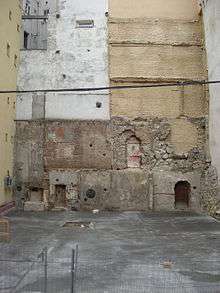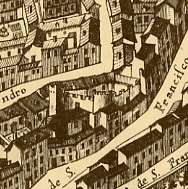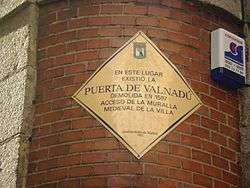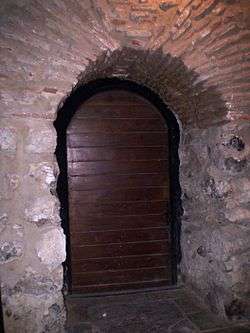Christian Walls of Madrid

The Christian Walls of Madrid, also known as Medieval Walls, were built in the Spanish city of Madrid between the 11th and 12th centuries, once the city passed to the Crown of Castile.
They were built as an extension of the original walled enclosure (9th century), of Muslim origin, to accommodate the new districts which emerged after the Reconquista. With the establishment of the Court in 1561, it fell into disuse, demolished almost entirely.
Still standing are some remains integrated into the structure of various buildings of El Madrid de los Austrias, a name designating the Habsburgs's historic center of the city.
The most important are in the calles (streets) of los Mancebos, of Don Pedro, of del Almendro, of Escalinata, of del Espejo, of de Mesón de Paños and of the Cava Baja and as in Plaza de Isabel II and in the underground parking of the Plaza de Oriente. The remains that are still standing were declared a Historical and Artistic Monument in 1954.
History

The tradition attributes to the King Alfonso VII of León and Castile (1126–1157) its construction, although it is assumed that work began before his reign, in the years immediately following the Christian conquest of Madrid (1083), during the times of Alfonso VI of León and Castile (1040–1109).
At the beginning of the 13th century, the Walls were not yet completed, as stated in the Fuero de Madrid of 1202: "all the caloñas of the Council invest in the works of the Walls until finished". Various municipal documents suggest that could be completed in the second decade of the 13th century.

The defensive role the Walls played after the Reconquista, as consolidation of the places snatched by the Christians to the Muslims, and in the process of Christian repopulation was blurring in the 14th century and, especially in the 15th century.[1]
The remarkable urban growth experienced by Madrid, with the development of new suburbs beyond the city walls, led to their demolition, especially after the 16th century, with the designation of the city as the capital of Spain.
Features




The Christian Walls of Madrid protected an area of just over 33 hectares (82 acres), as eight times larger than the space within the primitive Muslim Walls, of about 4 ha (9.9 acres). The total length was 2,200 meters (1.4 miles).
Unlike the Arab walled enclosure, built in quadrangular towers, the Christian structure was articulated from semicircular keep towers on layers of flint. The properties of this stone (which, when struck, causes sparks) gave rise to one of the historic city slogans: "I was on water built, my walls are of fire."
It is estimated that there could have been between 130 and 140 towers, one every 10 or 15 meters (33 or 49 ft). The Walls were surrounded by an outer moat, along most of the perimeter, and as supports the toponymy of some Madrilenian routes. The calles of Cava Alta, of Cava Baja and of Cava de San Miguel were drawn on this pit or cava, after it was covered.
It included four gates, constructed in turn, each protected by the proximity of one or more strong towers. There are not preserved any archaeological remains of them:
- The Puerta de Guadalajara, was the main gate of the city and the most sumptuous, given its location in a place of great commercial transit, located at the height of the number 49 of current Calle Mayor. It consisted of two large towers, across which stretched the entrance arch. The emperor Carlos V, Holy Roman Emperor (1500–1558) directed, in 1535, the demolition of the original Medieval gate and replaced it with a new one, with three arches and more ornamental, which disappeared in a fire that occurred on September 2, 1582.
- The Puerta de Valnadú (in other fonts, Balnadú) was possibly located in the center of the block defined by the calles of Lepanto, Carlos III and Vergara, near the Teatro Real.
- The Puerta de Moros, opened at south of the present Plaza del Humilladero, between the calles of Almendro and Cava Baja. It was destroyed in 1412 during an uprising.
- The Puerta Cerrada, located in the Plaza de Puerta Cerrada, was initially called Puerta de la Culebra, for the relief of a dragon carved on it. The name has come down to us after being closed, given the frequent crimes and assaults that took place inside. It was flanked by the Tower del Vinagre and was demolished in 1569, on the occasion of the entry into the city of Elisabeth of Valois, wife of Philip II.
At these accesses are added the three gates of the primitive Muslim Walls: the Arc de Santa María, the Puerta de la Vega, and Puerta de la Sagra.
Along the Walls were built several albarrana towers and watchtowers, which had a strategic location. These included the Tower de Alzapierna or de Gaona, that had a mandate to monitor sources Caños del Peral (in the current Plaza de Isabel II). The Tower de los Huesos, built in the 11th century by the Muslim population, was incorporated into the Christian Walls to protect the Puerta de Valnadú.[2] The remains of the latter are exhibited in the underground car park of the Plaza de Oriente.
Most relevant remains
The most important remains of the Christian Walls of Madrid are integrated in various buildings and urban infrastructures.[3] In most cases, its access is very limited, given the private nature of the apartment blocks where its are located:
- Cava Baja. In the number 30 of this route, it can see a fragment of the Christian Walls of approximately 20 meters long and 11 meters high (66 ft long and 36 ft high). It is in the courtyard of a farm where still stands the half intramural of the factory. At the height of the numbers 22 and 24, of the same calle, are located a section of foundation and base of a semicircular keep tower. Without leaving the Cava Baja, at number 10, there is a stretch of 7 m in length (23 ft) and a variable height between 1 and 4 m (3 ft 3 in and 13 ft 1 in), besides the ruins of a semi-cylindrical keep tower.
- Calle del Almendro. There, 16 meters long and 11 meters wide (52 ft × 36 ft wide) is the section that is preserved at the number 17 of this route. It is located at the bottom of a site and is visible from the street through a grilled door.
- Plaza de Puerta Cerrada. In the numbers 4 and 6 of the plaza is a piece of the Walls. This is the most complete surviving fragment and thus reaches the coronation. Even visible are the round path and the parapet. There are also remains of a tower.
- Plaza de Isabel II. In the number 3 can be seen a stretch in the basement of a restaurant of American cuisine, which is displayed to the public within the business hours of the establishment. Discovered in 1991, it presents masonry of flint, with two brick arches, probably corresponding to a late-medieval reform. In 1990 was excavated the base of the Tower de Alzapierna or de Gaona, within the existing metro station in the same plaza, but it was destroyed.
- Calle de la Escalinata. Between 1943 and 1945 were found different vestiges of a tower and a stretch of the Walls in the numbers 9 and 11 of this calle, near the Plaza de Isabel II.
- Calle del Mesón de Paños. In the numbers 11, 13 and 15 appeared in 1956 various remains very poorly preserved, as it proceeded to its partial demolition.
- Calle de los Mancebos. In the numbers 3 and 5 are the remains of a silo, with Islamic materials. Although form part of the structure of a building, can be seen from the calle, through a grilled door of protection.
- Calle del Espejo. In the number 14 is preserved a wall of ashlar of flint of 2.5 m high (8.2 ft), located inside a garage, accessible from the calle de la Escalinata. In the number 10 of this calle, there are also remains of a semicircular keep tower, in its party wall.
- Plaza de Oriente. The basis of the Tower de los Huesos, of Muslim origin and integrated by the Christians in their Walls, is exhibited in the underground parking of this plaza, built in 1996.
See also
References
- ↑ Gea Ortigas, María Isabel; Castellanos Oñate, José Manuel (2008). Muslim, Jewish and Christian Madrid. The Medieval Walls of Madrid. Madrid, Spain: La Librería. ISBN 978-84-95889-93-5.
- ↑ Castellanos Oñate; José Manuel (2005). "Second enclosure: Christian Walls". Spain: El Madrid medieval. Retrieved 2008. Check date values in:
|access-date=(help) - ↑ Gea Ortigas; María Isabel (1999). Las murallas de Madrid. Madrid, Spain: La Librería. ISBN 84-89411-29-8.
External links
| Wikimedia Commons has media related to Christian wall of Madrid. |
| Wikimedia Commons has media related to Castles in the Community of Madrid. |
- Information and photographs of the Christian Walls of Madrid in www.madridhistorico.com
- Information of the Christian Walls of Madrid in www.castillosnet.org
- Template:Link unavailable